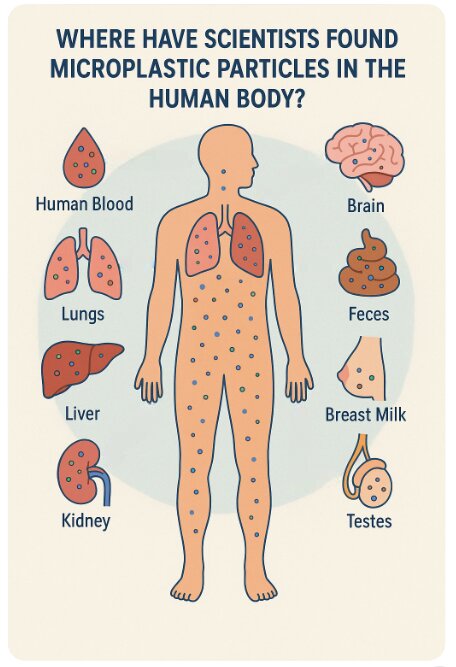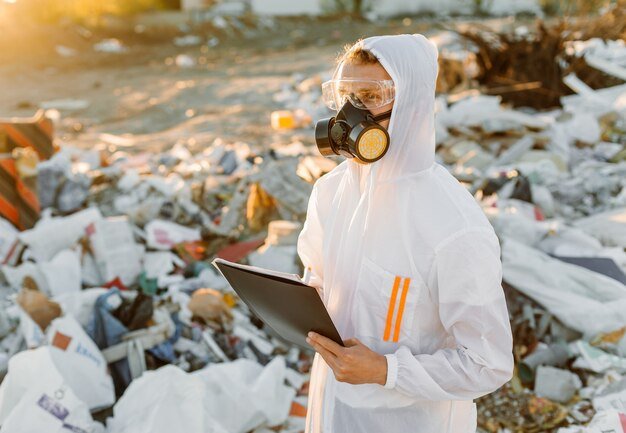Where Have Scientists Found Microplastic Particles in the Human Body?
When I first read that microplastics had been found in human blood, I felt a mix of disbelief and fear. It’s one thing to know our oceans are full of plastic—it’s another to realise it’s now circulating inside us. Scientists across the globe are uncovering microplastics in places they never expected: deep in our lungs, flowing through our bloodstreams, even nestled in the placentas of unborn babies. It’s unsettling, to say the least.
Microplastics are tiny bits of plastic, less than 5 millimetres in size. You might not see them, but they’re everywhere. They come from broken-down plastic bottles, shopping bags, and containers. They’re in the microbeads once used in face scrubs and toothpaste. They shed from our synthetic clothes in the wash and get released into water systems. Even the wear and tear of car tires leaves behind microscopic dust that becomes part of our environment.
There are two main types. Primary microplastics are intentionally small, like the microbeads used in some cosmetics. Secondary microplastics, on the other hand, form when bigger plastic items break down over time. Both types are small enough to be breathed in, swallowed, or absorbed by the body.
Through research, expert insights, and real-life stories, we’re starting to see just how far-reaching the plastic problem is. This isn’t just about polluted beaches or dead marine life. It’s about us—our health, our future. The fact that these particles are now inside human bodies makes it deeply personal.

In This Article
- 1. In Human Blood
- 2. In the Lungs
- 3. In the Placenta
- 4. In The Liver
- 5. In The Kidney
- 6. In The Brain
- 7. In The Testes
- 8. In Human Faeces
- 9. In Human Breast Milk
- Environmental Justice and Disproportionate Impact
- What Can We Do? Actionable Steps
- Conclusion
1. In Human Blood
In 2022, a pivotal study published in Environment International revealed that microplastics are present in human blood. Researchers from Vrije Universiteit Amsterdam analysed blood samples from 22 healthy adults and found that 77% contained microplastic particles, including polyethene terephthalate (PET), polyethene (PE), and polystyrene (PS).
The concentrations of these particles ranged from 1.6 to 4 micrograms per millilitre of blood. PET, commonly used in beverage bottles and food packaging, was the most frequently detected polymer, appearing in 50% of the samples. PE and PS, found in plastic bags and disposable cutlery, respectively, were also prevalent.
The discovery of microplastics in the bloodstream is concerning because it suggests these particles can travel throughout the body and potentially accumulate in organs. While the long-term health effects are still being studied, there is growing concern among scientists. For instance, a study published in the New England Journal of Medicine found that microplastics lodged in arterial plaques were associated with a higher risk of heart attack, stroke, and death.
Professor Dick Vethaak, an ecotoxicologist involved in the 2022 study, emphasised the significance of the findings, saying, “Our study is the first indication that we have polymer particles in our blood – it’s a breakthrough result.” He added, “It is certainly reasonable to be concerned. The particles are there and are transported throughout the body.”
2. In the Lungs
Also in 2022, researchers made another concerning discovery: microplastics were found in 11 out of 13 lung tissue samples from living patients undergoing surgery. These tiny plastic particles, including polypropylene and PET materials commonly used in packaging and textiles, were detected deep within the lung tissues, even in areas where such particles were previously thought unlikely to reach.
Every day activities contribute to this exposure. Wearing synthetic clothing, using plastic containers, and simply breathing in urban environments can introduce microplastics into our bodies. Household dust, laden with fibres from synthetic textiles and particles from degraded plastics, is a significant source.
The health implications are still being studied, but initial research indicates potential risks. Inhaled microplastics can cause respiratory inflammation and may trigger immune system responses. These particles can be engulfed by immune cells, leading to oxidative stress and potentially contributing to chronic respiratory conditions.
3. In the Placenta
In 2020, Italian researchers found microplastics in human placentas. The study, published in Environment International, analysed six placentas and detected microplastic particles, as small as 5 micrometres, in four of them. These particles were located on both the maternal and fetal sides of the placenta, as well as within the membranes surrounding the fetus.
This finding is deeply concerning because the placenta serves as a critical barrier, protecting the developing fetus from harmful substances. The presence of microplastics in this vital organ suggests that these particles can cross biological barriers and potentially reach the fetus. Dr. Antonio Ragusa, the lead author of the study, described the situation poignantly: “It’s like having a cyborg baby: no longer composed only of human cells, but a mixture of biological and synthetic entities”.
Concerns have been raised about potential impacts on fetal development and the immune system. Microplastics can carry toxic chemicals, and their presence in the placenta raises questions about possible interference with the fetus’s growth and immune responses.
Subsequent studies have reinforced these concerns. In 2024, researchers at the University of New Mexico found microplastics in all 62 placentas they examined, with concentrations ranging from 6.5 to 790 micrograms per gram of tissue. This widespread presence shows the potential of microplastics to affect human health from the earliest stages of life.
These findings highlight the urgent need for further research into the effects of microplastics on human health, particularly during pregnancy, and the importance of addressing plastic pollution to protect future generations.
4. In The Liver
A study published in EBioMedicine found six different types of microplastics in the liver tissues of individuals with cirrhosis, a severe form of liver disease. Interestingly, these particles were not detected in the livers of individuals without liver disease, suggesting a possible link between microplastic accumulation and liver health.
The liver plays a crucial role in detoxifying harmful substances from the body. The presence of microplastics in this vital organ raises concerns about potential health implications. While the exact effects are still being studied, researchers hypothesise that microplastics may contribute to liver damage by inducing oxidative stress and inflammation.
5. In The Kidney
A 2024 study confirmed the presence of microplastics in human kidney tissues and urine samples. Researchers analysed healthy kidney tissues from patients undergoing nephrectomies and urine samples from healthy donors, identifying microplastic particles ranging from 1 to 29 micrometres in kidneys and 3 to 13 micrometres in urine. The most commonly detected polymers were polyethene and polystyrene, materials prevalent in everyday plastic products.
The accumulation of microplastics in the kidneys is concerning due to the organ’s vital role in filtering waste and maintaining overall bodily health. Laboratory studies using human kidney organoids have shown that exposure to microplastics can disrupt kidney development, impair cell membrane integrity, and induce oxidative stress, leading to potential renal toxicity.
Furthermore, a scoping review led by researchers from Bond University found microplastics in 70% of kidney samples and 68% of bladder cancer cases, suggesting a possible link between microplastic accumulation and urinary tract health issues.
6. In The Brain
In a 2025 study published in Nature, researchers analysed brain tissue samples from 2016 and 2024. They found that the amount of microplastics in the brain had increased by approximately 50% over that period. The concentration was so significant that it equated to the weight of a plastic spoon. Notably, the brain tissue contained more microplastics than the liver and kidneys, organs traditionally associated with filtering toxins.
These microplastics were predominantly found in the frontal cortex, the brain region responsible for decision-making and muscle movement. The particles ranged from 5.5 to 26.4 micrometres in size, about a quarter the width of a human hair. The most common type detected was polypropylene, a plastic widely used in packaging and household items.
The presence of microplastics in the brain is particularly concerning because the brain is protected by the blood-brain barrier, which typically blocks harmful substances. The fact that microplastics can cross this barrier raises questions about potential health implications. While the exact effects are still under investigation, there is concern that these particles could contribute to neurological issues, especially given their accumulation in individuals with dementia.
7. In The Testes
Researchers from the University of New Mexico found microplastics in every human testicle they examined. Analysing 23 human and 47 canine samples, the team discovered that human testicles contained nearly three times more microplastics than those of dogs, averaging 329.44 micrograms per gram of tissue.
The most common types of microplastics identified were polyethene and polyvinyl chloride (PVC), which are commonly found in pipes and medical devices. Notably, higher levels of PVC in canine samples correlated with reduced sperm counts, raising concerns about potential impacts on human fertility. The study’s lead researcher, Dr. Xiaozhong Yu, expressed surprise at the extent of microplastic infiltration into the reproductive system and emphasised the need for further investigation into their effects on human health.
8. In Human Faeces
A 2019 pilot study published in the Annals of Internal Medicine by researchers from the Medical University of Vienna and the Environment Agency Austria analysed stool samples from eight healthy individuals aged 33 to 65, living in Europe, Japan, and Russia. The study found microplastics in all eight samples, with an average of 20 microplastic particles per 10 grams of stool. Using Fourier-transform infrared microspectroscopy, the researchers identified nine different types of plastic, indicating that these particles are entering our digestive systems through various means.
Common sources of microplastic ingestion include seafood, especially shellfish, bottled water, and table salt. Sea salt, in particular, has been found to contain microplastics in 90% of brands tested worldwide, reflecting the pervasive nature of plastic pollution. Bottled water also contributes significantly to microplastic intake, with studies showing that it can contain up to 7,000 particles per litre.
The types of microplastics commonly found in human faeces include polypropylene (PP) and PET, materials widely used in packaging and plastic bottles. These findings suggest that microplastics are not just an environmental issue but a human health concern as well. As research continues, it’s clear that reducing our reliance on single-use plastics and improving waste management practices are crucial steps in addressing this issue.
9. In Human Breast Milk
In a study conducted in Rome revealed that microplastics originating from materials like polyethylene, polypropylene, and PVC were present in 75% of breast milk samples collected from new mothers.
Understandably, this discovery has raised concerns among parents. The idea that microplastics could be present in something as natural and vital as breast milk is unsettling. However, it’s important to note that the health implications of microplastics in breast milk are not yet fully understood. While studies have shown that microplastics can cause cellular damage and inflammation in laboratory settings, their effects on human infants remain unclear.
Despite these findings, health experts continue to advocate for breastfeeding. Dr. Valentina Notarstefano, one of the researchers involved in the study, emphasises that the benefits of breastfeeding far outweigh the potential risks associated with microplastic exposure. Breast milk provides essential nutrients and antibodies that are crucial for a baby’s development and immune system.
Environmental Justice and Disproportionate Impact
The burden of microplastic pollution doesn’t fall equally on all communities. Low-income neighbourhoods and countries with inadequate waste management systems often face higher exposure levels. This disparity highlights a significant environmental justice issue.
In areas like Valenzuela City, a suburb of Manila, residents live near plastic recycling plants. The burning of plastics in these facilities releases harmful pollutants into the air, leading to respiratory problems among the local population. Children, in particular, are vulnerable, with increased reports of respiratory illnesses.
What Can We Do? Actionable Steps
1. Minimise Plastic Use
Opt for reusable alternatives like glass, stainless steel, or bamboo for food storage and daily use. Avoid single-use plastics whenever possible, as they contribute significantly to environmental pollution.
2. Choose Safe Food Packaging
Select containers labelled as BPA-free and phthalate-free to reduce exposure to harmful chemicals. Store food in non-plastic containers, and avoid heating food in plastic, as this can cause chemicals to leach into your meals.
3. Filter Tap Water
Use certified water filters that effectively remove microplastics. For example, the LifeStraw Home pitcher is designed to eliminate microplastics and other contaminants from tap water. Avoid bottled water, as it can contain microplastics and contribute to plastic waste.
4. Improve Indoor Air Quality
Regularly vacuum your home using a vacuum cleaner equipped with a HEPA filter to capture microplastic particles from dust and fibres. Ventilate living spaces to reduce indoor air pollution, and consider reducing the use of synthetic textiles in upholstery and carpets, as they can shed microplastics into the air.
5. Advocate for Change
Support legislation aimed at reducing plastic pollution, such as bans on microbeads and single-use plastics. For instance, the Microbead-Free Waters Act of 2015 banned plastic microbeads in cosmetics and personal care products in the United States. Encourage companies to take responsibility for their plastic use and to be transparent about their environmental impact.
Conclusion
This isn’t a dystopian novel. It’s our current reality. Microplastics are in us, around us, and potentially impacting our health in ways we are just beginning to understand. But with awareness comes agency. By staying informed, making conscious choices, and pushing for systemic change, we can reduce our exposure and protect future generations.
We are not powerless. We are the generation that can change the story.







